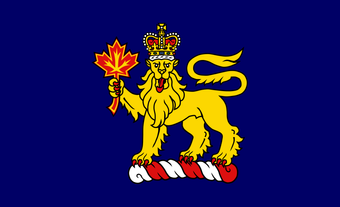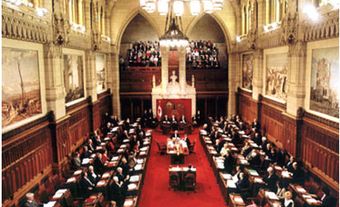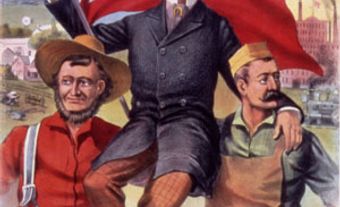The term Parliament refers to the Crown, the House of Commons and the Senate. Together, these institutions create Canadian laws. Parliament has two branches: the executive (the Crown, prime minister and cabinet) and the legislative (the House of Commons and the Senate). This system is a blend of parliamentary democracy and constitutional monarchy. It is based on the Westminster tradition in Britain. Each of the Crown, Senate and Commons must agree with (assent to) a law before it is enacted. The government of the day derives its authority from the people who elected it. It is therefore a representative government, even though it acts in the name of the Crown — a largely symbolic institution. In formal terms, Parliament includes all three bodies. But in common usage, the legislative branch is often equated with Parliament.
Executive Branch
Executive authority in Parliament belongs to the Crown (the monarch). It is carried out by the governor general on the monarch’s behalf, and by the prime minister and the cabinet. The choice of governor general is made by the prime minister and approved by the monarch. The governor general acts on the advice of the prime minister and cabinet. Legislation passed by the Senate and the House of Commons must receive Royal Assent from the governor general before passing into law.
Crown
The Crown refers to all of the executive powers exercised by or in the name of the sovereign. The sovereign is the head of state. They reign by hereditary right, as opposed to the head of government, who is elected. The Crown’s powers stem from rights and privileges known as prerogative powers. In 1947, all of the sovereign's powers and authorities in Canada were delegated federally to the governor general and provincially to lieutenant-governors. (See Letters Patent, 1947.)
According to the House of Commons Procedure and Practice, the Constitution reserves certain powers for the Crown:
- all bills approved by the House and Senate require the Governor General's Royal Assent to become law;
- the holders of many important offices are appointed by the Governor in Council;
- in theory, it is the Governor General who chooses the prime minister, but convention requires that they choose the leader of the party that can command a majority of votes in the House of Commons.

Prime Minister
The prime minister is the head of the federal government. They are usually the leader of the largest party in the House of Commons that is able to maintain the confidence (support) of Parliament. The prime minister’s main parliamentary duties include, but are not limited to: naming senators, directing Cabinet (the seat of government), and consulting with the governor general.
Cabinet
Cabinet is the committee of ministers that holds executive power. Cabinets are chaired by the prime minister. Its ministers are most often elected politicians from the party holding the most seats in the House of Commons. Unelected persons and senators may also serve in cabinet.
The capacity of cabinet to exert leverage on party members guarantees that the government's business will be protected from opposition votes. However, this power is often criticized. It is thought to undermine Parliament’s duty to hold government responsible by way of the confidence convention, which holds the executive to account. (See also Cabinet.)
Legislative Branch
Canada’s legislature is bicameral. This means that it has two separate chambers: the House of Commons and the Senate. When new laws are proposed, they are debated and subjected to votes in both the Lower House (Commons) and Upper House (Senate). A bill must be adopted in identical form by both houses before it can receive Royal Assent and pass into law.
House of Commons
The House of Commons currently has 338 members of Parliament (MPs). These are the elected representatives of federal electoral districts. There are no term limits for MPs; they can be re-elected any number of times.
The House of Commons has become the more important of the two chambers. This is mainly because the government of the day stands or falls on its support. Only the Commons can introduce bills on taxation and spending. But as with all bills, the Senate must pass them also. The Senate, despite its power to say no to Commons legislation, rarely obstructs the Commons because the Senate is not an elected body.
According to House of Commons procedure, “the prime minister and the cabinet are able to exercise authority only with the consent and approval (“confidence”) of a majority of the Members of the House of Commons.” For instance, in a minority government, the party that forms government does not hold the majority of votes required to ensure its approval. It must therefore earn its approval from members of other parties and independents.
The House of Commons’ capacity to act as the great debating forum for the nation is one of its strengths. According to constitutional requirement, Parliament (as well as each provincial legislature) meets at least once a year. Between 1867 and 1940, the annual sessions averaged four months. Now, they normally run a full year, with three long adjournments.
No more than five years should pass between elections. Only a war, invasion or insurrection can interfere with this guarantee. In 2007, Parliament passed a law that set a fixed election date. Under this law, the federal election is held on the third Monday in October in the fourth year following the last election. Elections can occur more frequently, namely during minority governments and wartime.

Senate
The Senate has 105 members, or senators. They are appointed and hold their seat until age 75, at which point they must retire. The Senate’s purpose is to consider and revise legislation (acting as a committee of “sober second thought”), investigate national issues, and provide the regions of Canada an equal voice in Parliament.
The bicameral nature of Parliament was necessary to bring provinces of varying size and power and with widely different regional concerns into Confederation. However, as a non-elective body, the Senate has been constantly subjected to calls for it to be abolished or reformed.
Speakers
The Speaker of the House of Commons and Speaker of the Senate are two important figures. They preside over their chambers, enforcing procedure and discipline in a non-partisan manner. The Senate Speaker is appointed by the governor general on the recommendation of the prime minister. The House Speaker was at one time appointed by the prime minister. Now, they are elected by MPs by secret ballot. Any member can be a speaker of their own house, though it tends to be a government member in each case.
Political Parties
Political parties are organizations that unite around an ideology. They seek to gain political office to develop their views and policies in law. They are the base upon which the business of the legislature is organized and conducted. Elections are fought and successful candidates find their seats in the legislature on a party basis. It is through parties that the Upper and Lower House and their committees conduct business. On rare occasions, independent candidates — who are not affiliated with a given party — win a seat in the Commons or are appointed to the Senate. In early 2014, Liberal Party leader Justin Trudeau expelled his party’s 32 senators from caucus. This caused some of those senators to sit as independents and others to sit as “Senate Liberals,” a group removed from the Liberal Party. This effectively gave independent senators a majority in the Senate.
As of February 2023, there were 39 independent senators, 15 Conservatives, 14 Progressives, 14 members of the Canadian Senators Group, and eight unaffiliated senators. There were also 16 vacant seats.
Opposition
Opposition in the House of Commons is meant to ensure respect for dissenting points of view. Opposition MPs sit opposite the government, acting as its watchdogs. The Official Opposition is usually the largest opposition party in the House of Commons. However, if two opposition parties hold the same number of seats, the Speaker designates which party becomes the Official Opposition. Along with the Official Opposition, other opposition parties (those with at least 12 seats) receive special funding to assist in research for the purpose of encouraging opposition, criticism and debate. The Official Opposition also acts as a “government in waiting.”
The leader of the Opposition is a formal office of Parliament. The leader can come from either the Senate or the House of Commons, but usually comes from the Commons. He or she sits directly opposite the prime minister (two swords’ length away). The Leader of the Opposition commands the same salary as a Cabinet minister and has the privilege of always asking the first question in Question Period. The leader of the Opposition must be consulted, by law, before certain decisions are made by government.
Parliamentary Procedure
A normal parliamentary session is divided into sitting days and adjournment periods. The prorogation of Parliament brings an end to a particular session. When reconvened, the new session begins with a Speech from the Throne. It announces the government’s legislative program for the session. Dissolution, which marks the end of a Parliament, can occur any time within the five-year period. It is invoked by the governor general on the advice of the prime minister. Dissolution involves an election and the formation of a newly elected Parliament.
Parliamentary privilege ensures that Parliament shall not only be unconstrained in what it can debate, but also that the individual legislators shall enjoy complete freedom of speech. The written rules of Parliament guarantee the rights of opposition parties to criticize without fear of retribution by the governing party. Privilege also protects legislators from slander for anything said in the chambers and committees. (See also Parliamentary Procedure.)
Committees
Parliament has many committees. They perform functions that cannot be accomplished in debate or during Question Period. Much of the day-to-day work of both the Senate and the House of Commons takes place in standing or special committees. There are six types of committees in total. (Standing committees, special committees, legislative committees, standing joint committees, and special joint committees.) The work carried out by committees helps inform parliamentarians on issues of concern to the public. They often collect information that is valuable to public debate.
Committees interact with citizens, bringing their voice directly to elected representatives. While Question Period receives full media attention, the valuable work in committees tends to go unreported. However, most of it is recorded by Parliament and available to the public.
The parliamentary librarian manages the Library of Parliament. They work under the direction and control of the Speaker of the Senate and the Speaker of the House of Commons. The Standing Joint Committee on the Library of Parliament assists the Speakers in that capacity. The librarian is appointed to their position by cabinet. They hold the same rank as a deputy head of a government department. As part of their regular duties, the parliamentary librarian chairs the committees that list candidates for the positions of parliamentary poet laureate and parliamentary budget officer.
The Library of Parliament provides research services to parliamentarians and committees, ensures the preservation of Parliamentary records, and provides outreach about Parliament to the public on behalf of Parliamentarians. The latter includes digitizing vast resources on the Parliamentary website and overseeing visitor access to Parliament itself.
Parliamentary Representation
The following chart lists the current breakdown of seats in Parliament and the provincial and territorial legislatures as of March 2023. It should be noted that the 2021 federal election was the last to take place with this allocation. A new distribution of seats — with a total of 343 in the House of Commons — will be in effect for the next election. (See also Redistribution of Federal Electoral Districts.) This new number is shown in parentheses.
|
Province/Territory |
House of Commons |
Senate |
Provincial/Territorial Legislature |
|
34 (37) |
6 |
87 |
|
|
42 (43) |
6 |
87 |
|
|
14 (14) |
6 |
57 |
|
|
10 (10) |
10 |
49 |
|
|
7 (7) |
6 |
40 |
|
|
1 (1) |
1 |
19 |
|
|
11 (11) |
10 |
51 |
|
|
1 (1) |
1 |
22 |
|
|
121 (122) |
24 |
107 |
|
|
4 (4) |
4 |
27 |
|
|
78 (78) |
24 |
125 |
|
|
14 (14) |
6 |
61 |
|
|
1 (1) |
1 |
19 |
See also Member of Parliament (MP); Canadian Party System; Canadian Electoral System; Prime Minister of Canada; Cabinet; Opposition Party; Leader of the Opposition.

 Share on Facebook
Share on Facebook Share on X
Share on X Share by Email
Share by Email Share on Google Classroom
Share on Google Classroom



























